Gallery
Here are a small selection of our before and afters. During your consultation with Dr Nick Koutroumanos, you will be shown more before and afters.
Upper Blepharoplasty
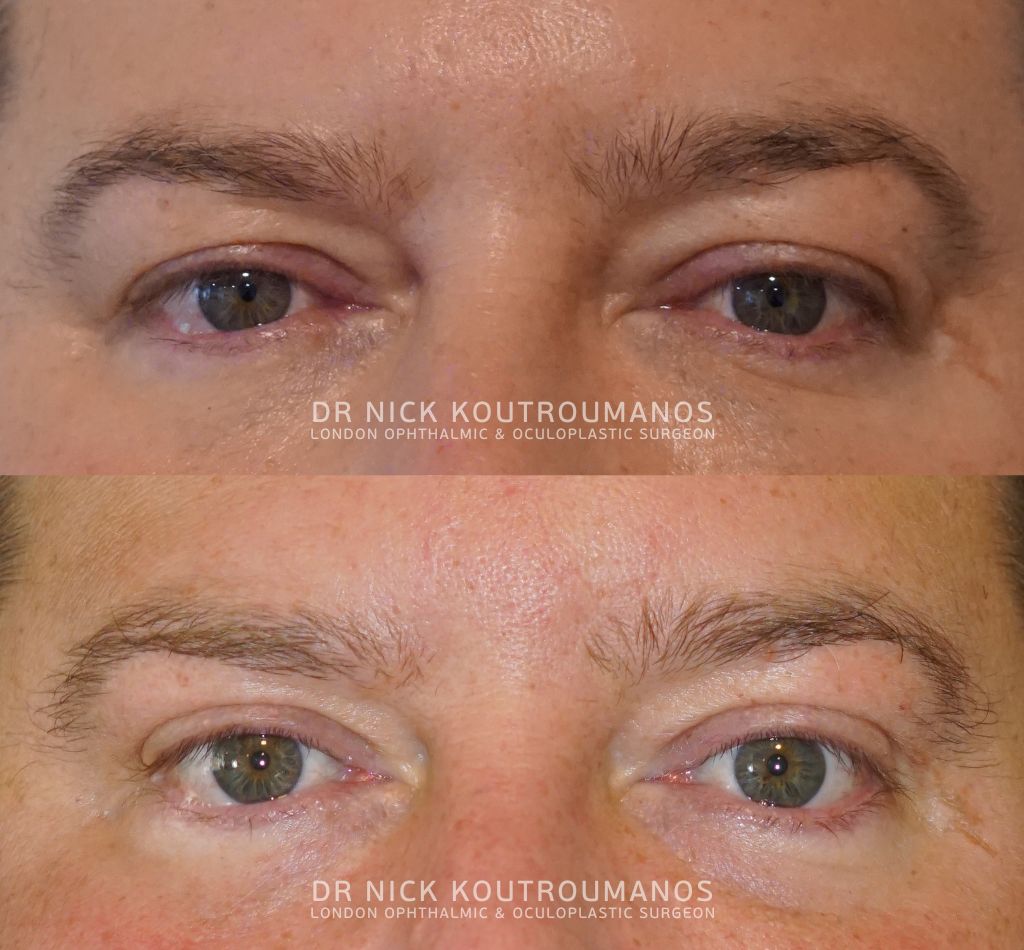
Here is a case of a successful interior designer who initially saw us reporting dissatisfaction with upper eyelid heaviness. Very well informed about his aims and objectives and certainly on the younger end of our spectrum of patients, he was after a light touch, natural looking opening up of his upper eyelid heaviness, while showing absolutely no evidence of surgery.
In the second image, six weeks later, we both felt that mission was very much accomplished!
The magic in blepharoplasty surgery in the detail: Super precise interventions leading to significantly more youthful appearance with zero evidence of any intervention having taken place.
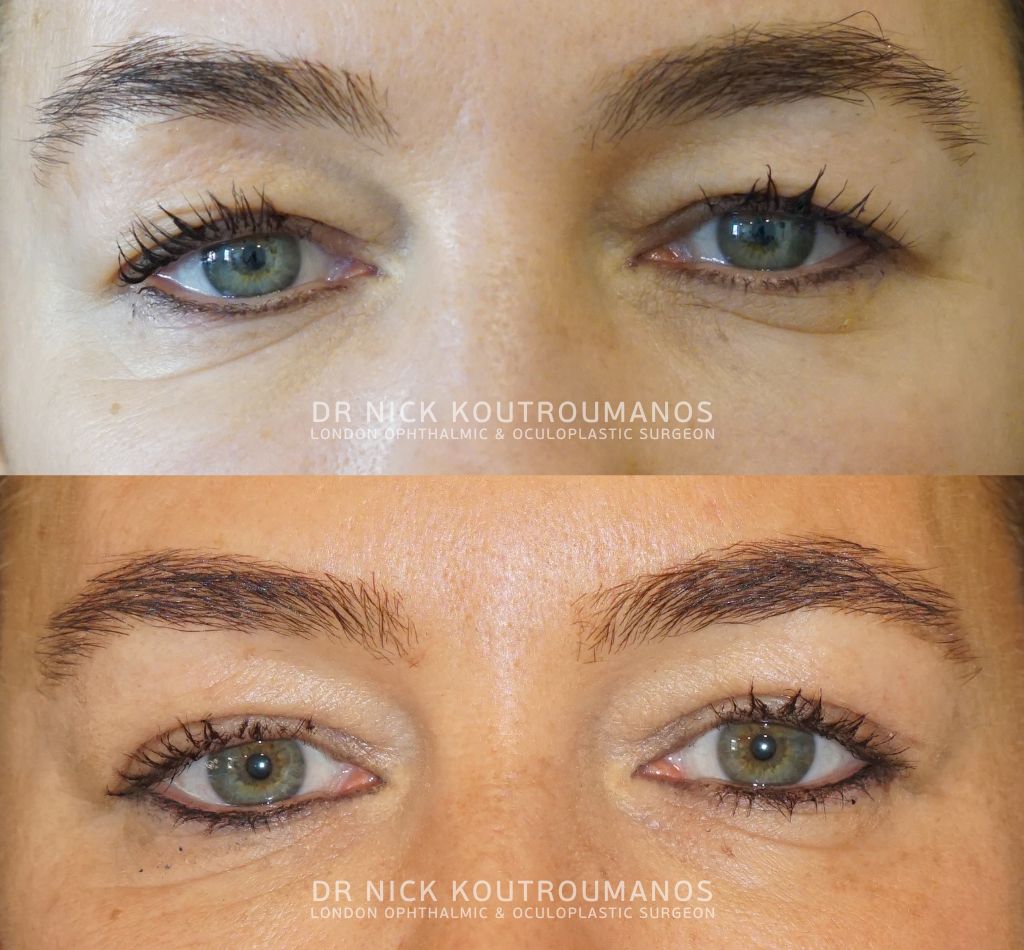
The eyes are our face’s main aesthetic unit. It is what defines us the most. Aesthetic eye surgery is all about retaining one’s identity. Expect a younger, fresher version of yourself with absolutely no signs of surgery. Make sure to see a specialist surgeon who will work with you to clearly define your goals.
This patient of ours came with clear expectations of wanting to retain her attractive upper lid fullness. She underwent a volume-preserving upper eyelid blepharoplasty and achieved exactly that, with a fresher, less tired version of herself.
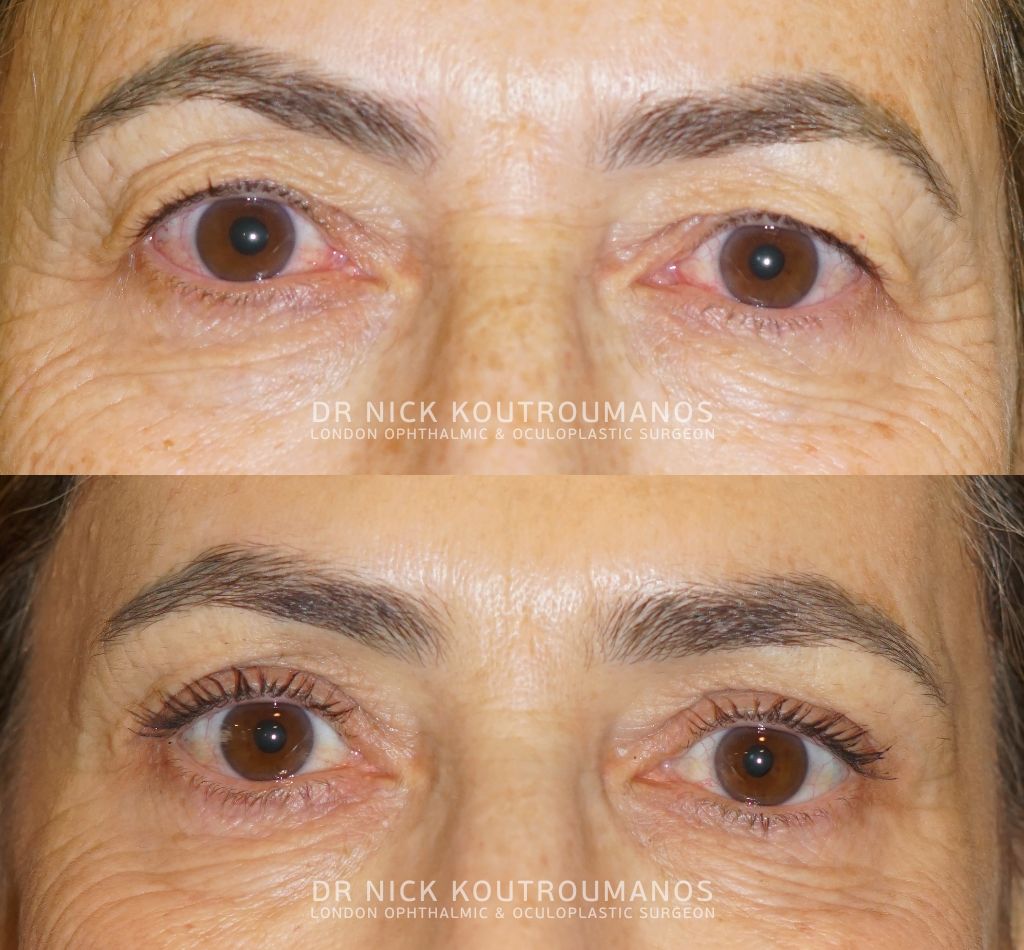
The ABC of our approach to upper blepharoplasty:
- Still look like yourself
- Natural results
- Zero signs of surgery
Typically, a small procedure with a big effect as this upper blepharoplasty patient exemplifies.
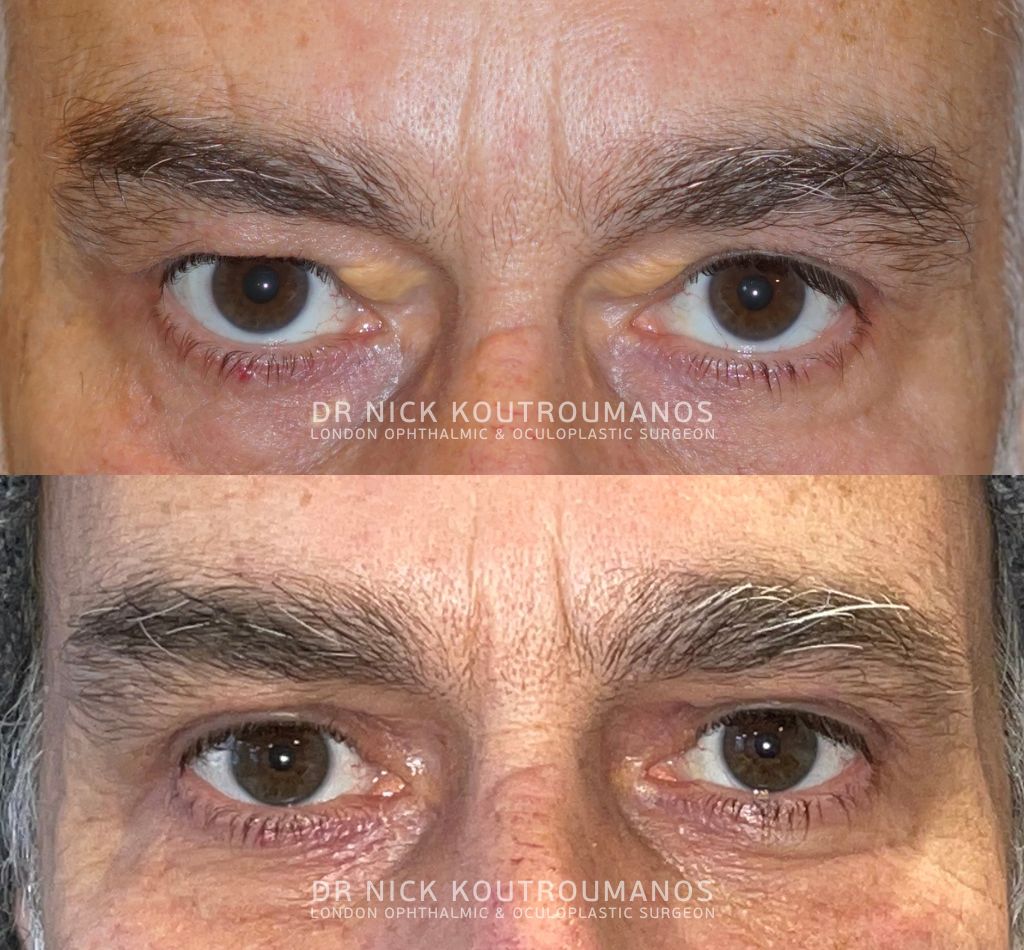
This lovely gentleman came to us to refresh his eye area by removing the xanthelasma and excess skin on his upper eyelids.
(Xanthelasma are yellowish bumps on or near the eyelids formed by cholesterol/fatty deposits that build up under the skin.)
Dr Koutroumanos performed a bilateral xanthelasma removal and upper blepharoplasty under local anaesthetic. The combined procedure took 60 minutes to complete.
A carefully constructed blepharoplasty can incorporate the fatty deposit lesions in a way that removal of the lesions and rejuvenation of the eye area, were achieved with a single procedure.
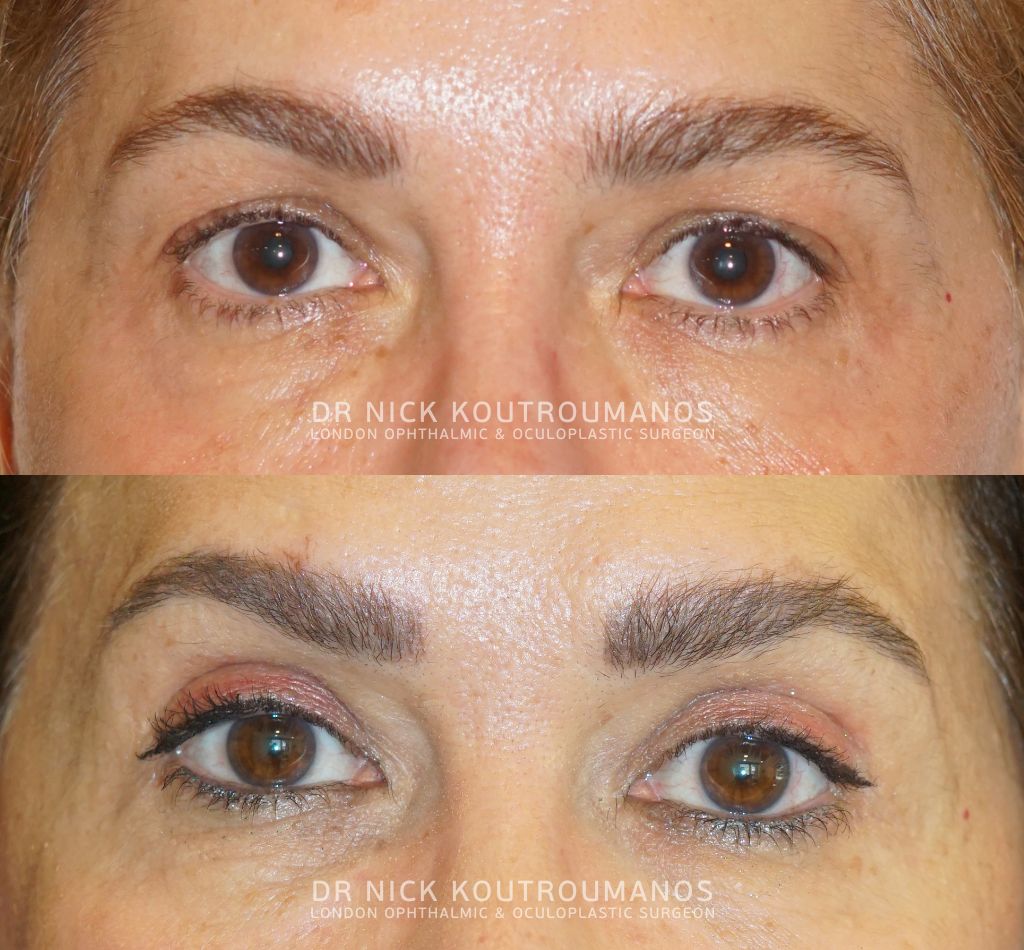
Very much like rhinoplasty and aesthetic breast surgery, Upper Blepharoplasty objectives vary between patients and therefore need careful alignment prior to surgery. Talk to your surgeon about the type of eyes you wish to have and bring photographs in your younger years.
Trends in upper lid aesthetic surgery keep changing, but the only trend which matters is your own expectations.
Thank you to our wonderful patient for sharing her images.



Dr Nick Koutroumanos prides himself on his natural outcomes and rapid recovery.
Here’s a guide to what you can expect in the first few weeks after an Upper Blepharoplasty.
Click through to see our patient immediately after surgery, one week after and three weeks after surgery.

Dr Nick Koutroumanos enjoys looking after detail-oriented individuals seeking specific alternations to their eyes, requiring minute surgical adjustments.
The precision required and the results that can be achieved are gratifying.
This patient visited us in London specifically desiring a symmetric upper eyelid show, without any evidence of surgery or the loss of her ethnic eyelid characteristics.
We carried out a right upper eyelid crease lowering and left sided blepharoplasty under local anaesthesia, and we are both delighted with her outcome.
In aesthetic eye surgery, even small changes can make a great difference.
Lower Blepharoplasty
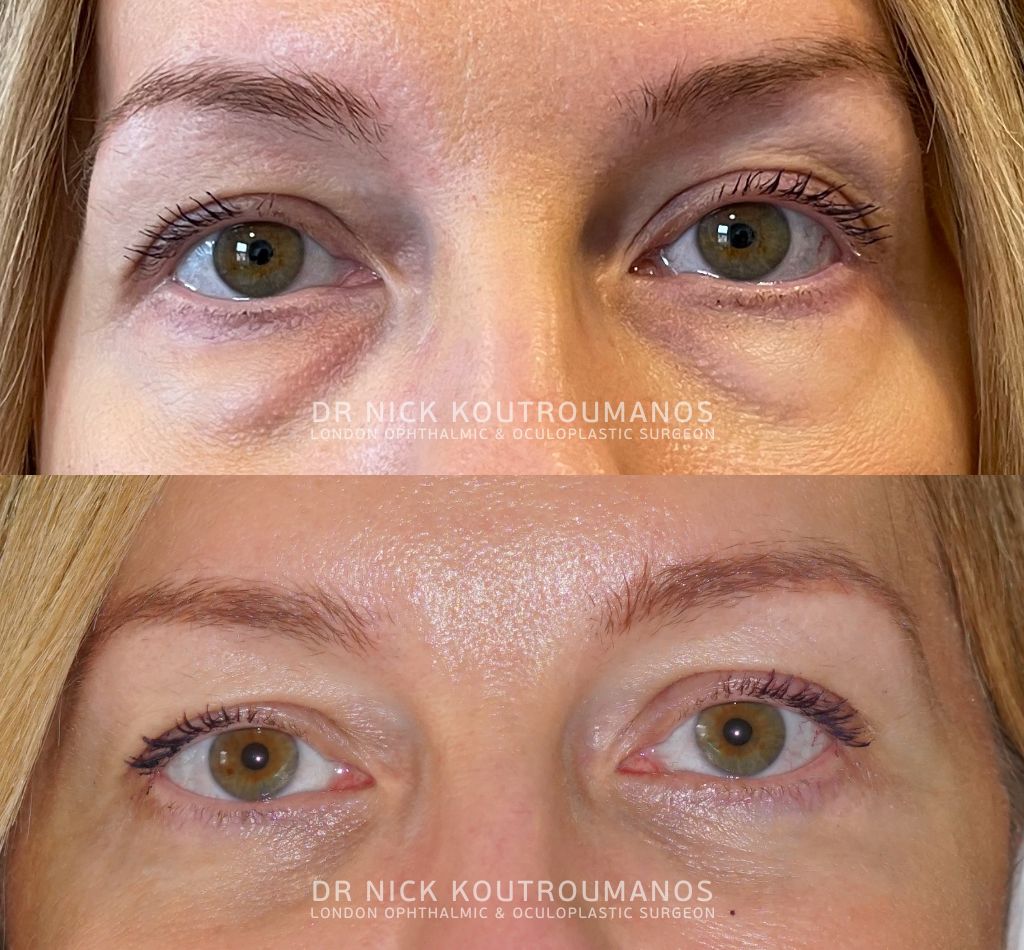
This patient chose us for under eye bag surgical treatment wishing to avoid non-permanent treatment solutions.
Her case demonstrates the internal scarless (also known as transconjunctival) lower blepharoplasty.
This is Dr Koutroumanos’ procedure of choice for most individuals seeking under eye bag treatment where excessive skin is not part of the problem. Down time is typically no longer than one, sometimes two weeks and often very little bruising is seen.
Transconjunctival surgery is extremely safe and reveals absolutely no signs of surgery having taken place.


Following aesthetic eye surgery, it’s important for our patients to be prepared for two or sometimes three weeks of noticeable bruising and swelling. However, the majority tend to recover much faster.
We are thrilled to be able to have one of our patients share her photos before the surgery and just seven days after.
To ensure a smooth recovery, we encourage you to consult our information on the link below. And remember, when you meet Dr Koutroumanos and his team, feel free to ask any questions, no matter how obvious they may seem.
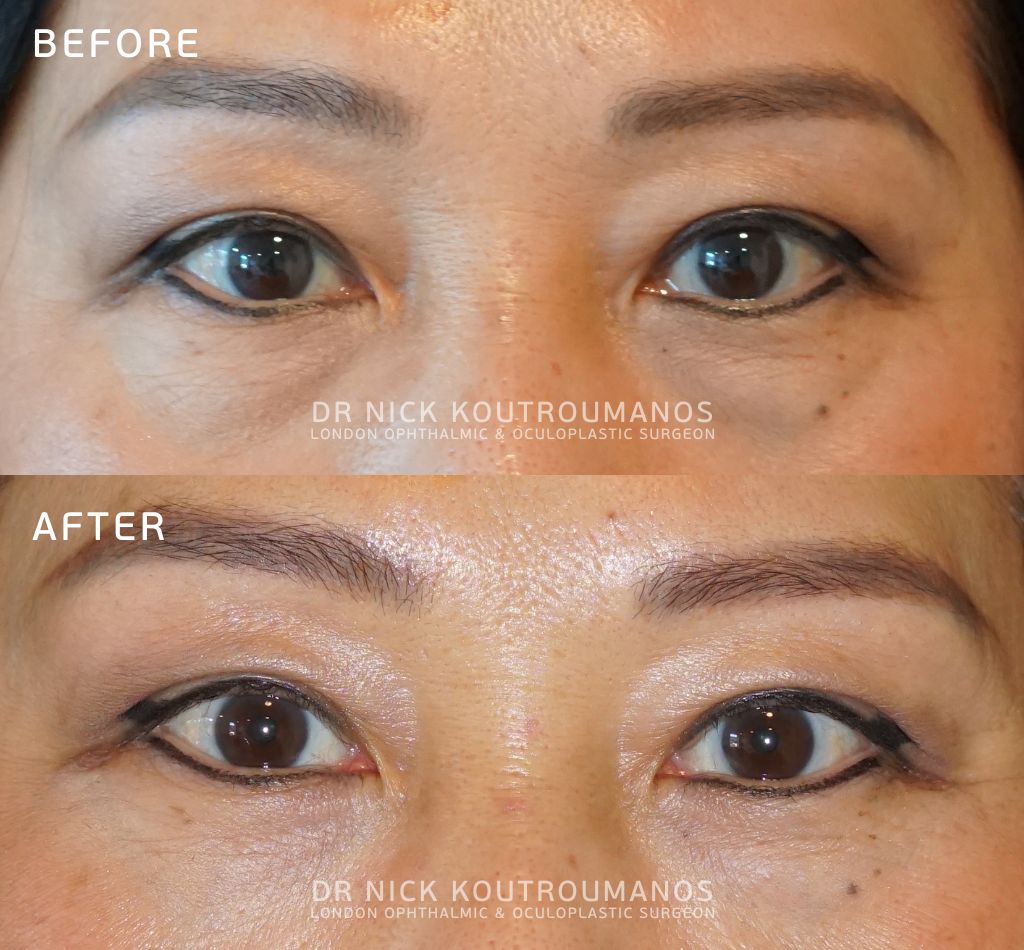
These before and after photos illustrate a no-incision (transconjunctival) lower blepharoplasty. This technique is characterised by minimal down-time and a complete absence of any tell-tale signs of surgery
Upper & Lower Blepharoplasty

Aesthetic eyelid surgery is a timeless option for addressing concerns that affect you. Our approach to surgical planning is always individualised and considers your age and specific requirements.
We understand that male patients particularly value natural-looking outcomes, and we are committed to ensuring that no traces of surgery are ever evident. Here’s one of our recent patients, a busy professional, who had been grappling with the frustration of sagging and puffy eyelids. Despite putting off the decision for quite some time, he ultimately opted for treatment.
The results, presented here at 3-weeks post-surgery, have exceeded his expectations, leading to a restoration of his confidence and a renewed sense of satisfaction. He has continued to improve since.
Surgery: Bilateral upper and lower blepharoplasty and ptosis repair
Duration: 90minutes
Blepharoplasty & Ptosis Repair Combined

This case nicely demonstrates the difference between Blepharoplasty and Ptosis Repair.
In the real world, the two procedures more often than not need to be combined, to different extents, to deliver symmetry and to rectify deformities arising from aging.
The eye on our left shows significant ptosis (eyelid droop) with a compensatory raised eyebrow and a prolapsed inner fat pad.
The eye on our right shows significant skin excess (dermatochalasis) requiring a blepharoplasty.
Both surgical procedures were carried out to different degrees on each side in order to deliver a symmetric eye size, symmetric eyelid and symmetric brow.
Revision Eyelid Surgery
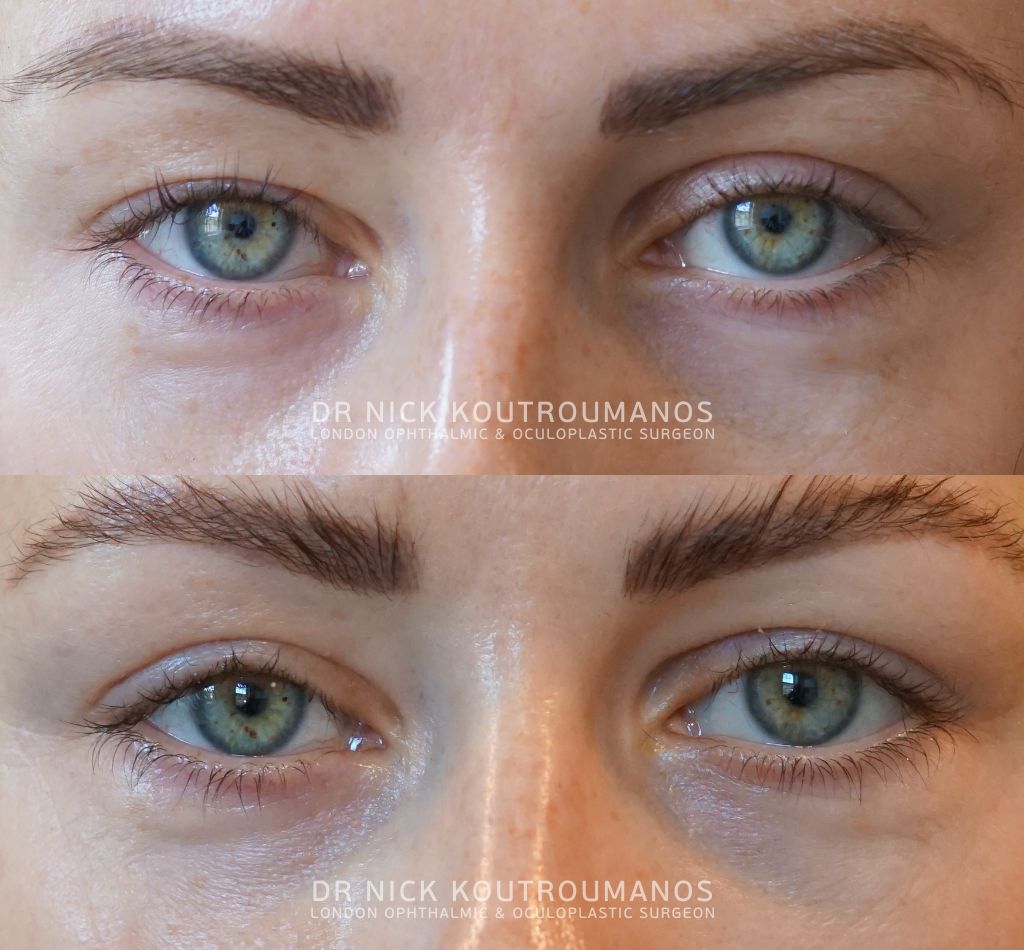
This young patient of ours had undergone surgery elsewhere which resulted in asymmetric upper eyelids. A carefully designed surgical adjustment was carried out under Local Anaesthesia which provided for perfect symmetry.
Dr Nick Koutroumanos’ extensive training and experience allows him to provide precise results, whether you’re looking for a dramatic improvement, or a subtle, yet confidence-enhancing refinement.
Eyelid Ptosis Repair

Another case of ptosis repair, or droopy eye lift carried out under local anaesthesia. Our now delighted patient had put off this procedure for a long time before finally making the decision to fly to London for a consultation.
Apprehension around eye surgery is very common given the sensitive nature of our eyes.
An assessment and a conversation with a clinician should be seen as an information gathering step, not a commitment and never the reason alone to proceed to surgery.

It is often subtle improvements or adjustments to their eyes’ shape and size that make the biggest impact on our patients and it’s this detailed, fine touch work that we most enjoy carrying out.
This patient underwent a symmetrising left upper eyelid lift (or ptosis repair) to correct a very bothersome asymmetry. Scarless surgery was carried out without any skin incisions (transconjunctival) ensuring no tell-tale signs of surgery. Operation time was just 30 minutes and downtime less that one week.
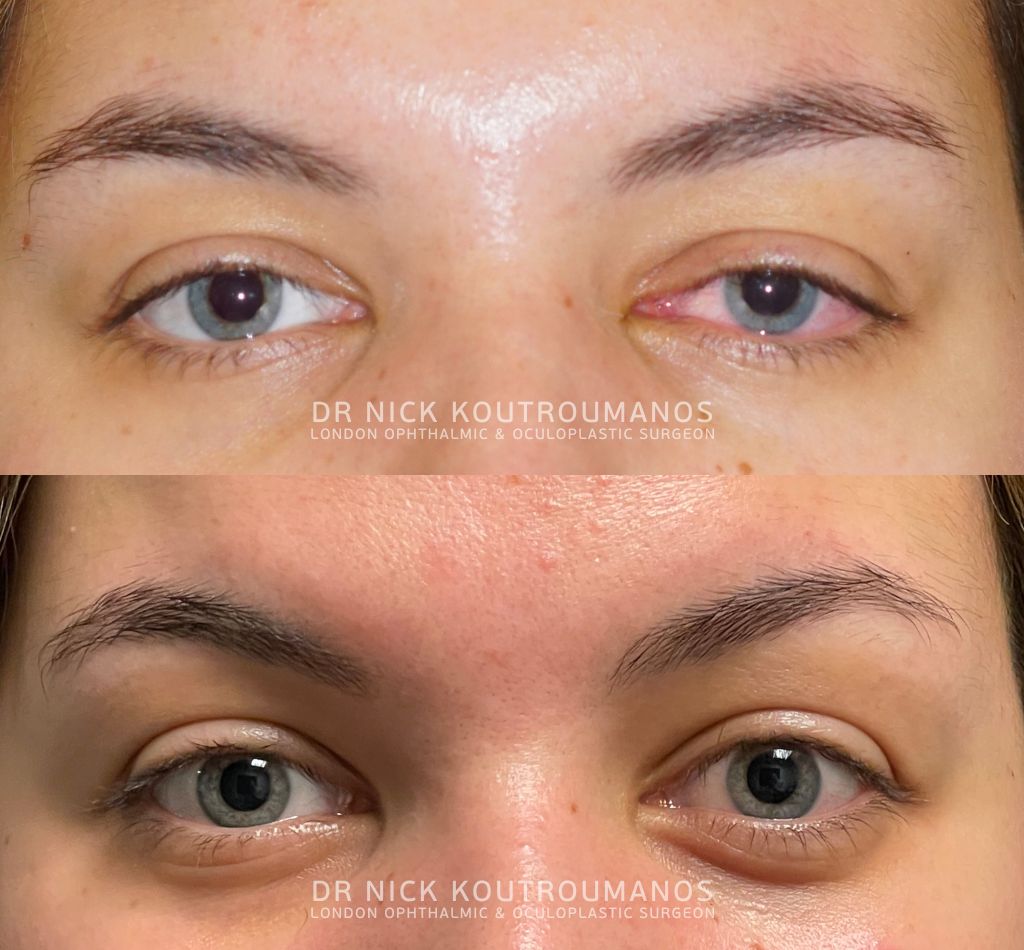
Minor surgery leading to major improvements. The effect that sleepy or droopy eyes (Ptosis) can have on a young professional are not minor. Patients come to us describing challenges in their social life, careers and relationships.
Ptosis repair has been scientifically proven to restore confidence and improve quality of life.

Some of our most cautious patients are often men.
This patient’s before and after photographs are taken at just three weeks after blepharoplasty and ptosis repair.

Ptosis repair works by tightening the muscle that opens the eyelid, called the levator muscle.
It is the procedure we use when the eyelids droop resulting in small eyes.
Just like with our patient here, we must carefully adjust the muscle to different extends on each side, in order to achieve as perfect a symmetry as possible.
Other than symmetry, the best outcomes are those characterised by a natural upper eyelid contour and the compete absence of surgical scars.

Eyelid ptosis, or drooping, is typically a condition presenting later in life due to wear and tear of the eyelid muscles, long term use of contact lenses or sometimes an injury. In a smaller proportion of individuals, ptosis will present at birth, due to the abnormal development of the muscles responsible for opening the eye.
Such cases require careful multidisciplinary management as they can result in poor eyesight development. In short, a child’s eye covered by a droopy eyelid, may lead to irreversible poor eyesight unless appropriately rectified and in the right time.
Surgery is technically challenging and requires expert input by an experienced oculoplastic surgeon. Good outcomes can result in remarkable improvements in children’s vision, in psychosocial development and quality of life with substantially improved opportunities in later life.
Congenital ptosis repair can also be a problem in young adulthood where treatment again can provide an outstanding boost in confidence.
The family of our young patient illustrated here consulted us for an opinion following unsuccessful surgery previously. We carried out a revision ptosis repair under general anaesthesia with a great outcome. A massive thank you to them for sharing her progress.
Eyelid Lumps & Growths
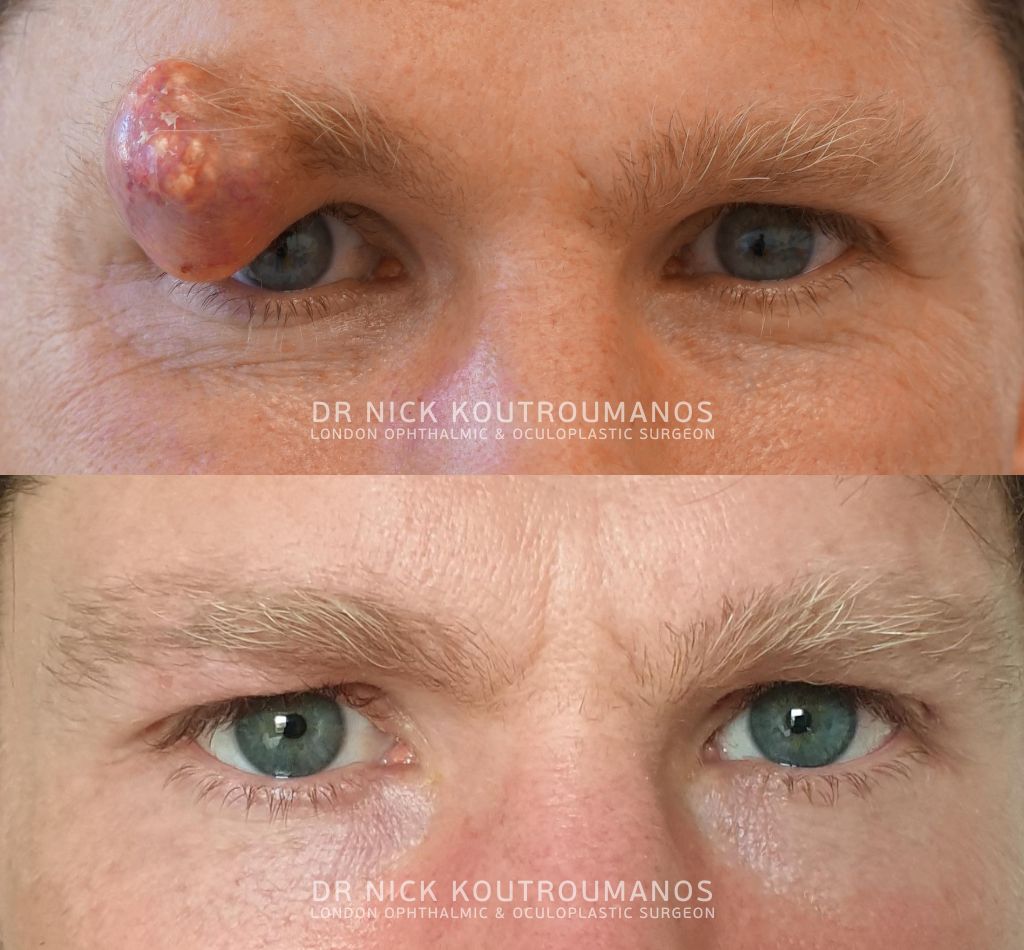
This is a progressively enlarging eyebrow tumour. Growths of such size (in this case a Pilomatrixoma) require specialised techniques to ensure that the patients’ facial structures and characteristics are not altered following removal.
Our patient here photographed on the day of surgery and six weeks later shows absolutely no permanent scar or deformity of his eyelid or eyebrow. Tissue analysis of the removed growth showed complete removal therefore posing no risk of recurrence.
As a rule, the sooner individuals who notice upper face lumps present to a specialist, the more straightforward treatment can be expected to will be.
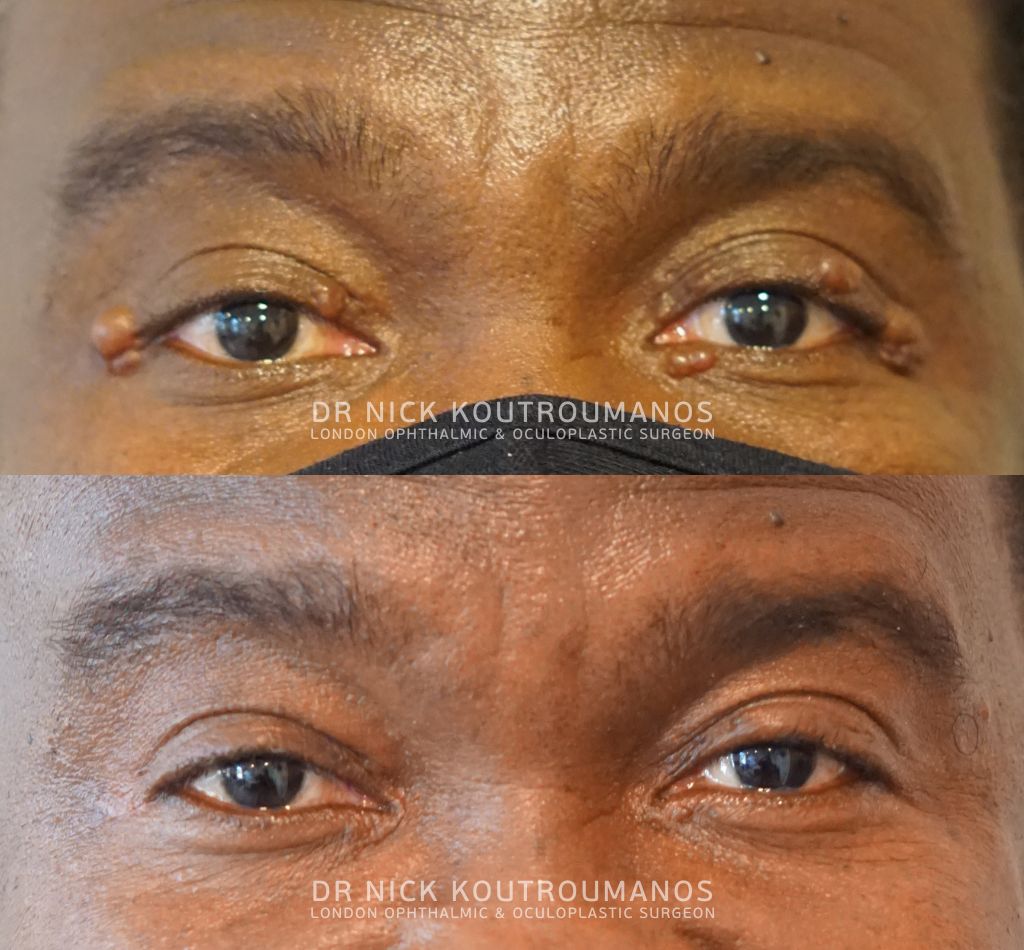
The eyelid area is rich in glands and as a result a common area for cysts to develop. Lumps and bumps such as these multiple sweat gland cysts on this patient of ours can be removed by simple in office surgery with minimal downtime and discomfort.
Most importantly, growths in the eyelid area ought to be assessed by a specialist prior to any such treatment, to ensure an appropriate plan is set in place. This will very often require analysis (biopsy) of the tissue to rule out sinister causes for the growths.


Skin tumours are very uncommon in young people and this is a fortunate thing for facial reconstructive surgeons who rely on laxity of tissues – like the kind which comes with ageing – to seamlessly reconstruct defects following tumour excision. In youth, there is very little tissue ‘give’ or wrinkles making procedures much less forgiving.
This young man suffered a recurrent aggressive pilomatrixoma, unusually requiring wide excision by the dermatologists. The challenge here was to repair the defect without any traction on the lower eyelid and this was achieved by a sliding island flap.
The outcome was both functionally and aesthetically successful and the patient totally free of his tumour. We thank him so much for sharing the images.
Please beware of stubborn growths on your skin and consult an appropriately trained physician when concerned.
Removal of BCC
Basal Cell Carcinoma is considered a non-aggressive skin tumour given its slow growth and extremely low metastasis rate. Tumours however which grow on areas with limited skin excess, such as around the eyes, can leave large gaps of no skin cover requiring reconstruction.
Periocular reconstruction needs to first ensure the safety of the eye by creating a normally functioning eyelid and then to deliver an as good as possible cosmesis. Such cases are best managed by oculoplastic surgeons working with dermatologists specialising in Mohs tumour removal.
Thank you to our patient for sharing his journey: A poorly defined (morpheaform) Basal Cell Carcinoma, identified late given its faint skin changes, leading to a large tissue defect addressed by cheek advancement.
Small lumps, nodules or non-healing ulcers can represent slowly-growing malignancies, most commonly Basal Cell Carcinomas (BCC), and the skin around the eyes, being thin and regularly exposed to UV radiation, is one of the commonest areas to develop these.
Thank you to our patient agreeing to share her images showing her BCC, the skin defect following Mohs Micrographic removal and the final reconstructed appearance.
The earlier these lesions are identified and treated, the easier it is to achieve an excellent cosmetic result.
Here is an unusual case of a teary eye, in this patient of ours presenting with a blocked, scarred tear duct in the inner aspect of her lower eye lid (image 1).
Close inspection of the area showed changes suspicious of a tumour and a biopsy confirmed a basal cell carcinoma.
She underwent Mohs micrographic tumour excision by our dermatologists (image 2) and a lower eyelid and tear duct reconstruction (image 3) resulting in a complete cure from the cancer, a satisfactory aesthetic and functional outcome and a full resolution of her watery eye.
Beware of any growths on the eyelids and seek a specialist opinion if concerned about recent changes.
Basal Cell carcinoma grows slowly and for that reason, it is often considered a not so aggressive tumour.
Patients in the UK usually present reasonably early, meaning that tumours are often small when removed and thus, easy to reconstruct what is left behind.
This is particularly important in the eyes area given that it is the least forgiving one in the human body; any slight scar contraction can put the eyes at risk.
Seemingly small, less well-defined skin tumours can result in substantial skin loss when microscopically removed.
Our patient was keen for her case to be shared to raise awareness on this fact, and we sincerely thank her for this.
Large neglected malignant tumours of the eyelid result in big surgical excisions which require creating new eyelids from nothing.
This practice is called periocular reconstruction and is carried out by oculoplastic surgeons.
Here is an example of an extensive basal cell carcinoma. Its removal meant the loss of most of the eyelids.
Reconstruction of a new lower eyelid and part of the upper lid has ensured the protection of the eye and acceptable cosmesis and symmetry.
The ‘after’ picture is at six weeks, and any residual scarring will fade away over the next few months.
Technique: Free tarsal graft, periosteal flap, modified cheek flap.




















